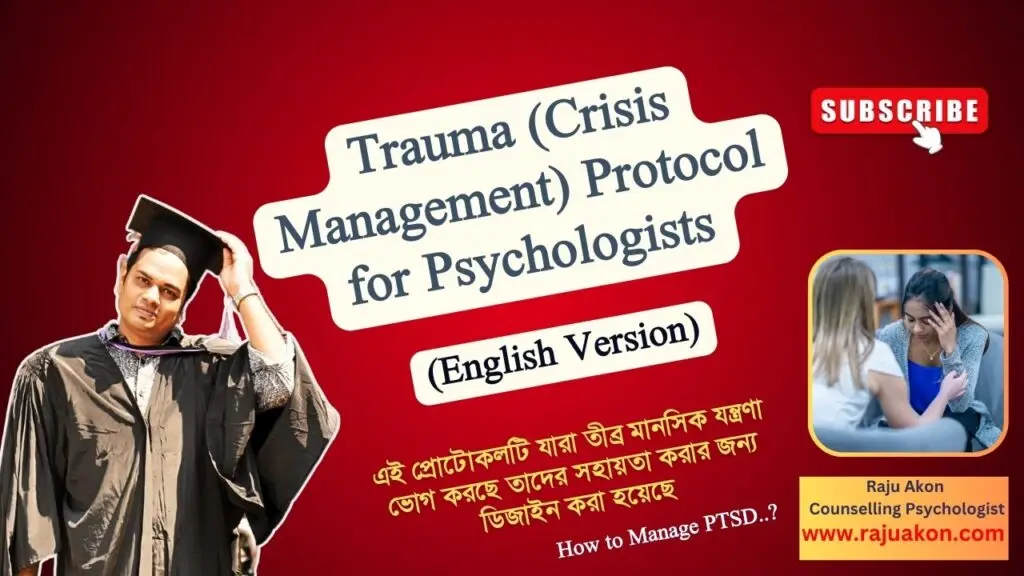Hello, I am Raju Akon, a mental health practitioner. As a Counseling Psychologist with an MPhil Part-1 from DU, I am dedicated to supporting individuals navigating through crises. Below, I am sharing a specialized Trauma or PTSD protocol designed to assist those experiencing acute psychological distress. This protocol aims to provide immediate relief, ensure mental safety, and help strengthen resilience in the face of challenging circumstances
Here’s a detailed breakdown of the CPM-MH protocol for counselling psychologists to apply when working with patients during the acute phase:
CPM-MH Protocol: Service for the Acute Phase
1. Self-Introduction & Establishing Connection
- Objective: Establish rapport and build trust.
- Approach: Begin by introducing yourself to the patient in a calm and reassuring manner. Let them know that you are there to support them, and emphasize that they are not alone in this journey.
- Example Phrases:
- “I’m here with you, and we will get through this together.”
- “You are not alone; I am here to help you.”
2. Validation of Common Emotional Responses
- Objective: Normalize the patient’s emotional reactions.
- Approach: Acknowledge the common emotional responses to trauma without delving into the specifics of their experiences. Reassure them that their feelings are normal and understandable given the circumstances.
- Example Phrases:
- “It’s normal to feel this way after what you’ve been through.”
- “Your reactions are valid, and many people feel the same way after similar experiences.”
3. Working for a Sense of Security in Uncertain Contexts
- Objective: Help the patient regain a sense of safety and control.
- Approach: Focus on creating a secure environment for the patient. Discuss the uncertainties they may feel about the future and offer reassurance without making unrealistic promises. Emphasize their ability to take control over their immediate environment.
- Example Phrases:
- “Let’s focus on what we can control right now.”
- “We’ll take this one step at a time, and I’m here to support you.”
4. Mental Safety First: Butterfly Hug & Positive Affirmations
- Objective: Enhance emotional and mental stability.
- Approach: Use the Butterfly Hug technique to help the patient connect with their body sensations. Guide them through affirmations such as “I am safe now” and “I survived.” Encourage them to recall positive memories that can help stabilize their emotional state.
- Technique Details:
- Butterfly Hug: The patient crosses their arms over their chest, placing their hands on opposite shoulders. They then gently tap their shoulders in an alternating rhythm, which can help regulate their nervous system.
- Positive Affirmations: Lead the patient in repeating phrases like “I am safe now,” or “I have survived.”
5. Grounding Techniques
- Objective: Bring the patient’s focus to the present moment.
- Approach: Teach the patient simple grounding techniques that engage their five senses. Incorporate normal breathing exercises, reverse counting, and mindful observation of their surroundings to anchor them in the present.
- Examples:
- 5 Senses Grounding: Encourage the patient to focus on what they can see, hear, smell, touch, and taste in the current moment.
- Reverse Counting: Guide the patient to slowly count backwards from 100, which can help distract them from distressing thoughts.
6. Following the Recent Event Protocol of EMDR
- Objective: Address the recent traumatic event using EMDR (Eye Movement Desensitization and Reprocessing).
- Approach: Apply the EMDR Recent Event Protocol to help the patient process the traumatic memory. Focus on reducing the emotional charge associated with the memory and reinforcing positive cognitive restructuring.
- Process Overview:
- Identify the distressing event and its associated emotions.
- Use bilateral stimulation (e.g., eye movements, taps) while the patient focuses on the memory.
- Guide the patient in replacing negative thoughts with positive ones.
7. Strengthening Resilience
- Objective: Build the patient’s resilience and coping mechanisms.
- Approach: Reinforce the patient’s positive memories and experiences through slow bilateral stimulation (BLS). Use techniques like the Spiral Technique and Light Streaming to help them visualize and internalize their strengths.
- Examples:
- Positive Memory Reinforcement: Use 8 to 10 slow BLS sessions while the patient recalls positive experiences.
- Spiral Technique: Visualize a spiral that represents the patient’s journey, with each turn symbolizing growth and strength.
8. Managing Anxiety & Stress
- Objective: Equip the patient with strategies to handle anxiety and stress.
- Approach: Discuss previous coping mechanisms the patient has successfully used in the past. Encourage them to apply these strategies in their current situation and assure them of the confidentiality of their counseling sessions.
- Example Questions:
- “Can you recall a time when you managed stress effectively? What did you do?”
- “Let’s explore how we can use those strategies again to help you now.”
9. Assurance of Confidentiality
- Objective: Build trust by assuring privacy.
- Approach: Clearly communicate to the patient that everything discussed in the sessions will remain confidential, which can help them feel more secure in sharing their thoughts and feelings.
- Example Phrases:
- “Everything you share with me is confidential. This is a safe space for you.”
10. Self-Grounding for Self-Stability
- Objective: Encourage the patient to practice self-grounding techniques.
- Approach: Teach the patient simple self-grounding exercises they can use independently to stabilize themselves when feeling overwhelmed.
- Examples:
- Deep Breathing: Instruct the patient to take slow, deep breaths, focusing on the sensation of air filling their lungs.
- Mindful Observation: Encourage them to mindfully observe their surroundings, noticing details that they hadn’t paid attention to before.
Conclusion: This detailed protocol ensures that, as a counselling psychologist, you can provide comprehensive and empathetic care to patients in acute phases, focusing on their immediate needs while laying the groundwork for long-term healing.
Resources:
- Trauma (Crisis Management) Protocol for Psychologists (Bangla Web Version)
- বাংলায় ট্রমা (ক্রাইসিস ম্যানেজমেন্ট) প্রোটোকল
Writer:
Raju Akon
Counselling Psychologist, MPhil part-1-DU, PMHCC

